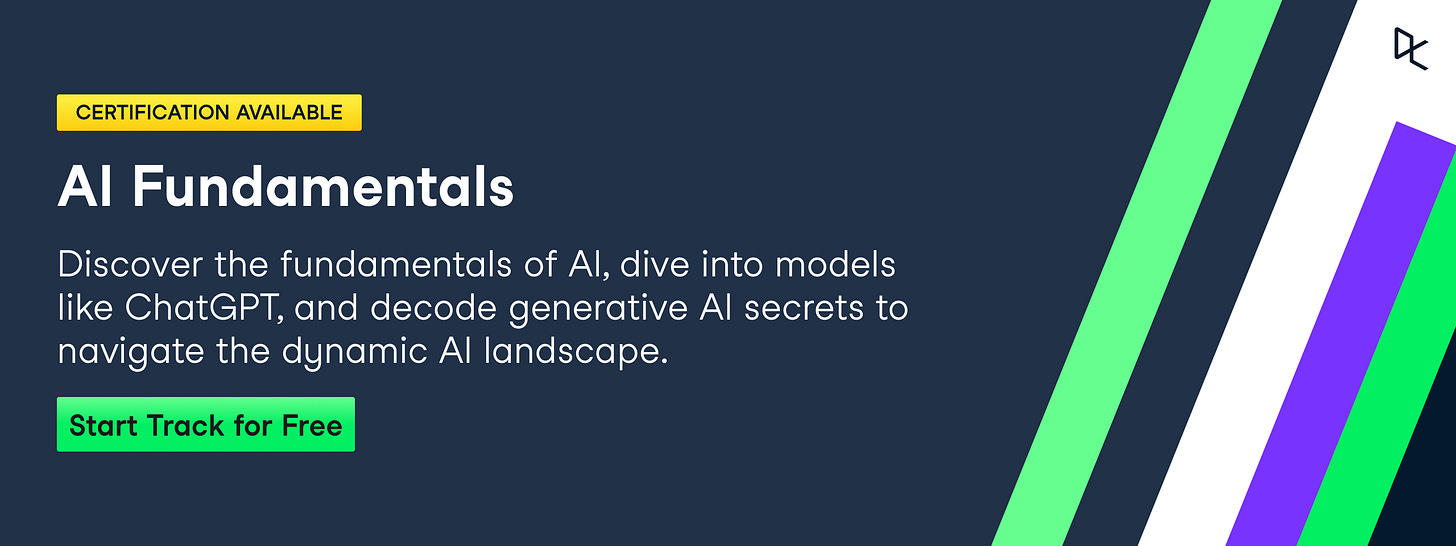AI for All or Just a Few? OpenAI Goes PBC, AI Code Editors Take Off
Mission meets profit, code becomes language, and Agatha Christie teaches a creative writing masterclass—50 years after her death.
Welcome to The Median, DataCamp’s newsletter for May 9, 2025.
In this edition: OpenAI restructures as a Public Benefit Corporation, Apple experiments with AI search, AI code editors are on the rise, and more.
This Week in 60 Seconds
OpenAI Transitions to Public Benefit Corporation (PBC)
OpenAI has announced a change in its corporate structure, transitioning its for-profit LLC to a Public Benefit Corporation (PBC). This means that while still a for-profit entity, the company is legally bound to consider the interests of both shareholders and its mission. OpenAI was founded as and will continue to be overseen and controlled by its nonprofit arm. PBCs are a type of purpose-driven company structure that has become standard for other AGI labs like Anthropic or xAI. We explore and explain the PBC structure in the deep dive section.
Apple Considers Integrating AI Search in Safari
Apple is reportedly exploring a significant shift in its Safari web browser, considering integrating AI-powered search engines and potentially moving away from its current default partnership with Google. This move could jeopardize the estimated $20 billion-a-year deal that makes Google the default search offering in Safari. Apple's SVP of Services, Eddy Cue, believes AI search providers like OpenAI, Perplexity AI, and Anthropic PBC could eventually replace traditional search engines and that Apple will bring these options to Safari in the future. Apple has already incorporated OpenAI's ChatGPT into Siri and plans to add Google's Gemini later this year.
Mistral AI Launches Mistral Medium 3 Model
Mistral AI has announced the release of Mistral Medium 3, a new model positioned to balance state-of-the-art performance with 8X lower cost and simpler deployment for enterprise use cases. The model is designed for professional applications, excelling particularly in coding and multimodal understanding. Mistral AI highlights that Medium 3 performs competitively with or surpasses larger and more expensive models on various benchmarks, while also being cheaper than some cost-leading models.
Apple and Anthropic Partner on AI Coding Platform
Apple is reportedly teaming up with Anthropic to develop a new AI-powered "vibe-coding" platform aimed at helping programmers write, edit, and test code. The system is a new version of Apple's Xcode software that will integrate Anthropic's Claude Sonnet model. Apple plans to roll out the platform internally before deciding on a public release, signaling the company's push to use AI for improving internal workflows and modernizing product development.
OpenAI Reportedly Acquires Windsurf for $3 Billion
OpenAI is reportedly set to acquire Windsurf, an AI-assisted coding tool previously known as Codeium, for approximately $3 billion. Windsurf offers features like an agentic code editor and tools for writing, editing, and testing code. The acquisition is seen as a move to enhance ChatGPT's coding capabilities and strengthen OpenAI's position in the competitive AI coding assistant market, which includes rivals like GitHub Copilot and Cursor. Some reports suggest the deal is also strategic for gaining valuable training data from Windsurf's user base. Questions have been raised about the future of Windsurf's support for other AI models, and the acquisition may face regulatory review.
Cursor AI Raises $900M at $9B Valuation
Anysphere, the company behind the AI-powered code editor Cursor, has reportedly raised $900 million in a new funding round. The investment values Anysphere at approximately $9 billion. This represents a significant increase from the company's $2.5 billion valuation in January 2025. The substantial funding highlights continued strong investor interest in the rapidly growing AI coding tool market. Anysphere, founded in 2022 by MIT graduates, has seen rapid adoption of its Cursor tool. We explore the rise of AI code editors in the deep dive structure.
Learn AI Fundamentals With DataCamp
A Deeper Look at This Week’s News
The Purpose of PBCs in AI
OpenAI's recent announcement that its for-profit arm will transition to a Public Benefit Corporation (PBC) structure highlights a growing trend among prominent AI labs. This move, also adopted by companies like Anthropic and xAI, raises questions about the evolving corporate structures in the pursuit of artificial general intelligence (AGI) and whether a for-profit model can truly align with a mission focused on benefiting all of humanity.
What is a Public Benefit Corporation?
Traditionally, for-profit companies prioritize shareholder value above all else. A Public Benefit Corporation, however, is a legal structure that requires companies to consider the interests of all stakeholders—including shareholders, employees, the community, and the environment—and to pursue a stated public benefit alongside profit.
In the context of AI, this "public benefit" is typically tied to the company's foundational mission, such as developing AI safely, ensuring it benefits humanity, or promoting open access.
Why do AI companies choose the PBC structure?
The development of cutting-edge AI is incredibly capital-intensive, requiring billions, potentially trillions, of dollars in investment for compute, research, and talent. A traditional nonprofit structure, while mission-driven, can face limitations in raising this scale of capital.
The PBC model allows these companies to access significant for-profit investment while, in theory, legally binding them to their public-benefiting mission. As OpenAI noted, the PBC structure replaces more complex prior arrangements and is seen as better suited for a world with multiple AGI development efforts.
Balancing mission and profit: Is a PBC enough?
Does the PBC structure guarantee that these companies will always prioritize their mission over profit? It provides a legal framework and public commitment that strengthens the hand of those within the company advocating for the mission. It also offers transparency regarding the company's stated public benefit.
However, the inherent tension between generating returns for investors and adhering strictly to a potentially costly or restrictive mission remains a challenge. The effectiveness of the PBC structure in truly safeguarding a company's mission in the long run will likely depend on the specifics of its governance, the commitment of its leadership, and the ongoing dialogue with regulators and the public.
The Rise of AI Code Editors
Recent news, such as Apple's partnership with Anthropic, OpenAI acquiring Windsurf, and Cursor AI's significant funding, shows an intense focus on AI code editors. These developments underscore the powerful demand driving innovation in this space. But what exactly is fueling this market?
Productivity is the key driver
At the core of the demand for AI code editors is their proven ability to enhance developer productivity. These tools, like Cursor and Windsurf, use AI models to move beyond simple auto-completion. They can understand complex project contexts, generate code from natural language descriptions, help identify and fix bugs, and even automate multi-step development tasks.
To learn how to set up and use Cursor and Windsurf, check out these two blogs:
Evidence from usage patterns
Data from reports analyzing how developers use AI models provides clear evidence of this demand. Findings from Anthropic, for instance, indicate that a substantial portion of AI model usage is already directed towards software development activities, including tasks like UI design, debugging, and scaffolding web and mobile applications.
Source: Anthropic
The appeal of "vibe coding"
The concept of "vibe coding," a term that's gained traction recently, describes a development approach where programmers (and non-programmers alike) tell an AI what they want using plain language, and the AI generates, tests, and even adjusts the code. This approach, facilitated by tools like Cursor and Windsurf, is fundamentally changing workflows.
However, relying on AI for coding also comes with notable downsides. Concerns include potential issues with code quality that may not be immediately apparent, increased security risks if AI-generated code isn't rigorously reviewed, the danger of overreliance on AI leading to a decline in core coding skills, and limitations in handling highly complex or custom requirements.
Learn more about the pros and cons of vibe coding in this blog.
Industry Use Cases
Agatha Christie Teaches Writing—Posthumously, via AI
BBC Maestro has launched a writing course led by Agatha Christie—who died nearly 50 years ago. Using AI-enhanced visuals and audio, the course reconstructs her voice and likeness to deliver lessons in her own words. Built from interviews, letters, and manuscripts, and created with full support from her family and a team of scholars, the project shows how AI can be used to bring historical figures to a modern audience for educational purposes.
Travel Industry Explores AI for Holiday Booking
Online travel companies are beginning to implement AI tools to improve the process of booking holidays. Firms such as Expedia, Trip.com, and Booking.com are developing AI assistants intended to help users plan trips and create personalized itineraries, aiming to reduce the effort involved in booking. However, these tools are still in early development. Initial testing shows they can sometimes produce unsuitable results, such as suggesting an airport hotel for a romantic getaway. Concerns also exist regarding the potential for errors, vulnerability to manipulation, and the challenge of accurately capturing diverse user preferences.
Salesforce Reimagines Sales with AI Copilots
Salesforce’s 25,000-strong sales team is now augmented by AI tools like Sales Coach and Agentforce, helping sales representatives prepare for client meetings, run mock negotiations, and generate instant research. Sellers use the tools to role-play conversations, summarize past calls, and even pull objection-handling advice mid-meeting. While some worry AI might undercut human connection, Salesforce positions it as a silent partner who helps people better focus on the pitch.
Tokens of Wisdom
The first company that generates AGI to the level we're thinking about will be the first trillionaire in the world. They'll have cornered markets in so many ways because they'll be so far ahead of the competition. They won't even see who's in second place at that point. So what's going to cause them to lighten up on that gas pedal?
—Christopher DiCarlo, Senior Researcher and Ethicist
In the context of our deep dive on the structure and limits of PBCs, we recommend listening to this discussion with Professor Christopher DiCarlo:








What about Gemini-2.5-Pro-Preview-05-06?
You missed a big one for coding
https://web.lmarena.ai/leaderboard